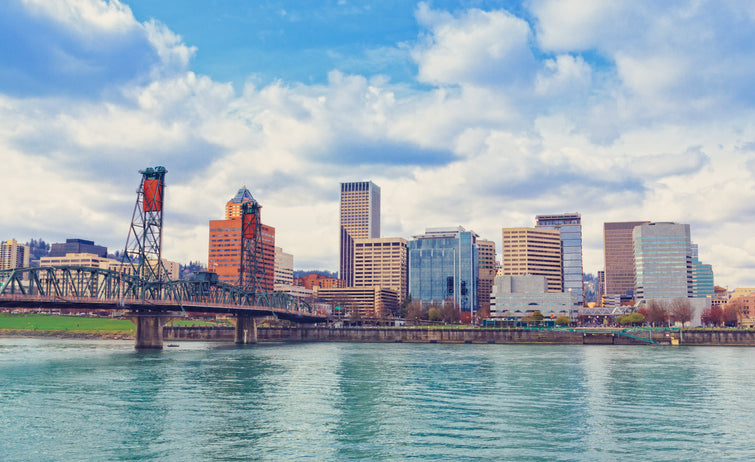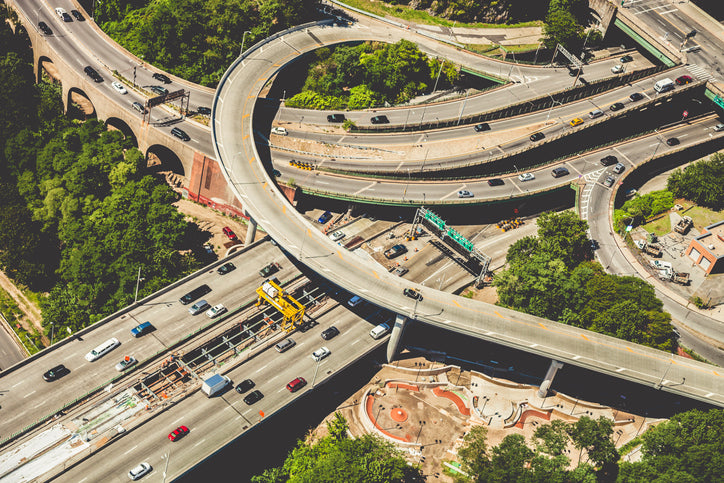Air quality data has shown that air pollution in parts of the U.S. has consistently grown worse over the last few years. According to the American Lung Association, “More than four in 10 Americans, or about 43.3 percent of the population, live in counties that have monitored unhealthy ozone (often called ‘smog’) and/or particle pollution (often called ‘soot’),” both of which have significant implications for health and can even make indoor air quality worse.
While most of the US has cleaner air quality than even just a decade ago, escalating weather conditions are exacerbating pollution in many cities. In essence, higher temperatures have increased ozone levels, and changing rain patterns have caused more frequent wildfires, thus creating higher particle pollution.
Below are the seven states with the worst air quality, compiled and ranked using data from the American Lung Association’s (ALA) State of the Air 2019 report.
#1: California

California consistently ranks as the most polluted state in the country. Six of the top 10 most polluted cities (for year-round particle pollution) are in California, with the Fresno-Madera area ranking as the most polluted city in the country. California cities like Bakersfield also rank as the worst for short-term particle pollution, as well as Los Angeles for the worst ozone pollution in the nation.
The Golden State is the most highly populated state in the U.S. with the fifth largest economy in the world. Its most significant sources of air pollution come from automobile traffic, as well as industrial pollution. The local topography in the state, especially in farming regions, along with its warm weather, lends itself to trapping pollution within valley walls, increasing the levels of ozone. Wildfire smoke also contributes to poor air quality, and the threat of these extreme air quality events are on the rise.
#2: Pennsylvania

Pennsylvania, a state with a long-standing coal industry, has consistently struggled with ozone and particle pollution, according to the ALA. Five cities in PA rank in the top 25 most polluted cities (for year-round particle pollution), with Pittsburgh at #7 for its high particle pollution. As one of the main metropolitan sub-regions of New York, PA is also impacted by the regional ozone pollution. And according to State Impact Pennsylvania, 16 of 36 counties for which the ALA had data were graded a D or F for ozone levels.
On a more positive note, as the use of natural gas over coal has increased since 2003, the state has experienced a steady annual decrease in particulate matter.
#3: Texas

Two of the top 25 most polluted cities (for year-round particle pollution) are in Texas, the second most populous state in the nation. The Houston area, home to two major airports, ranked 17th for annual particle pollution out of 203 metropolitan areas.
Pollution in the Lone Star State comes from what the Texas Commission on Environmental Quality calls “point” and “non-point” sources. Point sources tend to be large and stationary, such as fossil fuel fired power plants, smelters, industrial boilers, petroleum refineries and manufacturing facilities. Non-point consists of everything else—namely area, on-road mobile, non-road mobile and biogenic sources.
#4: Washington

Four out of the top 25 cities for short-term particle pollution are located in Washington, with two of them in the top 10. The ALA’s “State of the Air” 2019 report found that recent wildfires had significantly impacted the Seattle-Tacoma region’s air quality significantly enough to raise it from the 15th most polluted in the country in 2018 to ninth this year for short-term particle pollution. The Yakima area ranked sixth.
Much of the outdoor air pollution in Washington State comes from motor vehicles, outdoor burning and wood smoke, according to the Washington State Department of Health. Equipment powered by gas and diesel, some industries and wildfires are also significantly contributing to air pollution.
#5: Oregon

Oregon makes the list with four of the top 25 most polluted cities for short-term particle pollution, including Medford and Grants Pass and even the scenic Portland area (along with its neighboring areas in Vancouver, Washington).
According to the Oregon Department of Environmental Quality, Oregon has a high amount of particulate matter due to “air toxics,” which commonly come from motor vehicles and industry sources, including diesel soot, benzene, by-products from auto exhaust and industrial sources, as well as metals including manganese, nickel and lead.
#6: Alaska

Despite its vast open spaces and expanses of nature, two of the top 25 most polluted cities for short-term particle pollution are located in Alaska. Moreover, for year-round particle pollution, Fairbanks, Alaska ranked third out the top 10 most polluted cities, while Anchorage ranked twenty-first out of the top 25 most polluted cities. Short-term particle pollution in places like Fairbanks is particularly bad in the winter when residents burn wood for heat.
According to the State of Alaska’s Division of Air Quality, the state’s particle pollutants come from dust, land clearing open burning, wood stoves, wildfires and volcanic ash. Cars and trucks also significantly contribute to emissions.
#7: Utah

Two Utah cities (Salt Lake City and Logan) are on the list for the top 25 most polluted cities for short-term particle pollution. Ozone is another concern, especially in winter because of temperature inversions, which occur when cold air at the surface becomes trapped beneath warmer air. In Utah winters, snow-covered valley floors reflect heat instead of absorbing it. This prevents the “normal vertical mixing of warm and cold air that keeps pollutants from building up to unhealthy levels at the surface.”
The majority of the fine particles found in Utah’s air pollution comes from vehicles and area sources including homes (particularly those with wood burning stoves), small businesses and commercial buildings, according to the Utah Department of Health. Businesses such as gas stations, dry cleaners and home heating, as well as manufacturing are other contributors.
Other states with air quality concerns
Montana
Montana’s air quality challenges should also be noted, since three of its counties are in the Top 10 counties for short-term particle pollution. The decreasing air quality is linked to climate change, particularly as it has caused more wildfires.
New York
Within the state of New York, New York City is ranked 10 out of the top 25 most ozone polluted cities in the nation. Much of the pollution comes from vehicle emissions, fossil fuel combustion (for generating electric power) and heating/cooling residential buildings, according to the New York Department of Health.
Connecticut
Connecticut is impacted by ozone pollution along with its neighbors New Jersey and Pennsylvania. It received a grade of “F” from the ALA for each of its counties due to its high ozone days.
What factors contribute to a state having the worst air quality?
To determine the “worst” air quality in a state we reviewed the ALA’s State of the Air report to see how many times a given city (and its counties, where applicable) in a state showed up in the top 25 rankings lists for year-round particle pollution, short-term particle pollution (24 hours) and ozone days. We also took into consideration the city’s proximity to major metropolitan areas. Additionally, we paid attention to other geographical factors that bring more ozone and particle pollution such as region (the West and the Southwest, for example, are notoriously high in ozone) and areas with warmer weather, which contributes to air pollution.
When talking about pollution, the primary sources are particle pollution and ozone levels. According to AirNow, particle pollution is comprised of solid and liquid particles that come from a variety of sources, industrial and civilian emissions, fires, as well as chemical interactions in the atmosphere. Ozone, which is often best known for protecting us high up in the atmosphere against ultraviolet light, becomes problematic near ground level, where it is created by pollutants that react chemically with sunlight and has negative impacts on health.
To obtain the data for its report, the ALA drew from the most recent pollution data, gathered by the federal, state and local governments and tribes in 2015, 2016 and 2017. For year-round particle pollution rankings, the report uses data collected by the U.S. Environmental Protection Agency’s (EPA) Air Quality System (AQS).
In Conclusion
Air pollution has a significant impact on many factors of health, especially to vulnerable groups like children and those with chronic illnesses. Particle pollution can increase the risk of such conditions as heart disease, lung cancer and asthma attacks, as well as interfere with the normal functioning of the lungs. Ozone can lead to breathing problems, cardiovascular issues, and can even shorten one’s lifespan.
The more you know about air quality, the better you can avoid polluted, unhealthy places and situations. For a day-to-day glance at the air quality in your state and city, check out the air quality index (AQI) on AirNow. A more overarching snapshot of a state’s air quality in the form of your state’s report card can be found on the SOTA website. If you are living with an illness or sensitivity (such as asthma) you can use these websites to determine safe days to engage in outdoor activities.
You should also keep in mind that outdoor air pollution, especially particle pollution, travels indoors as well, and indoor air pollution can be even worse than outdoor pollution. Take steps to reduce indoor air pollution by staying indoors on days when outdoor pollution is high, and minimize activities within the house such as cooking, painting or using household cleaners that could further contribute to poor air quality. The EPA also suggests ensuring that you have good ventilation and regularly cleaning air ducts and filters.








